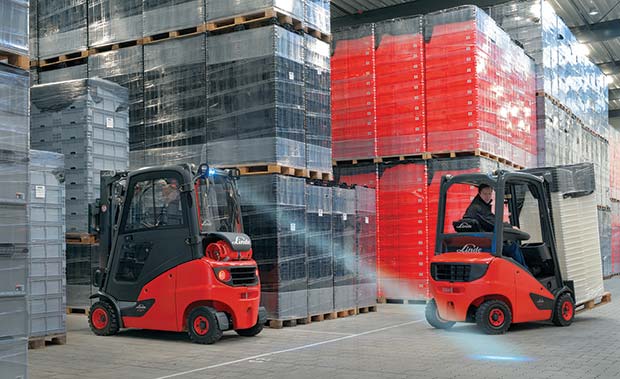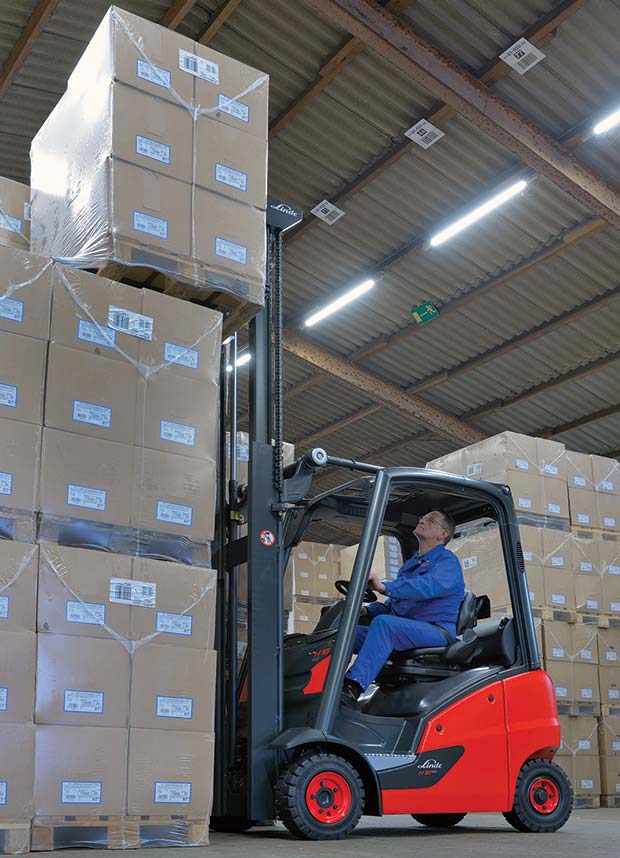Following the launch of the Linde H14-H20 EVO, industrial truck manufacturer Linde Material Handling has now completed the range and taken the smallest series in the 1.4 to 2.0 tonne load capacity range to the next level. Recognisable by the black design element, which extends into the red-painted chassis, the small EVO now also features significant functional improvements, including the Linde Curve Assist for appropriate driving speed during cornering, a more comfortable seat and armrest generation and a choice between three different driving modes that enable adjusting the energy consumption and power requirement to match the operating conditions.

For perfectly safe cornering manoeuvres every time, Linde has continued to offer the Linde Curve Assist as standard across all its electric and IC counterbalance trucks in the 1.4 to 5-tonne load range. This electronic system reduces traction speed automatically depending on steering angle, thereby reducing the risk of accidents.
Noticeably enhanced comfort
At the same time, operators of the new small IC series can look forward to the latest generation of seats, which gives them the advantage of simple weight adjustment, optimised seat pressure distribution, improved whole body vibrations and a choice of mechanical suspension or air suspension. The optional “Super Active Comfort” seat with climate control is available to suit operators comfort. Furthermore, the redesigned armrest with Linde Load Control also adds to their comfort by ensuring the arm can be positioned in the optimum position to reduce strain. Operators can easily adjust the length and height of the armrest to their body size using the single-point adjustment mechanism. The armrest also features an integrated storage compartment for wallets, keys or mobile phones.
Economical and durable
Even though the price of diesel is currently lower than it has been for a long time, fuel efficiency continues to be a topical issue. In addition to components such as an economical 26 kW engine and the unique Linde hydrostatic drive, the Linde H14 to H20 EVO models now also feature an electric fan which individually adjusts the temperature of the hydraulic oil, cooling water and charge air, thereby ensuring an energy efficient cooling system. Moreover, three different performance modes allow selection of the most favourable ratio between fuel consumption and power requirement: the Efficiency standard mode, the more energy-saving Economy mode and the Performance mode for maximum handling capacity. A recent performance test carried out with a diesel forklift H16 D and an LPG-powered forklift Linde H18 T showed that with this new series Linde is clearly ahead of competitors in energy consumption and handling capacity.
Reliability in use is one of the most important requirements for all operators of industrial trucks. For this reason, the electronic Linde Engine Protection System is installed in the new Linde H14 to H20 as standard. It monitors the most important vehicle parameters, shows warnings on the display screen in case of low levels or high temperatures , if necessary, reduces the power output to protect the engine from further damage. The monitored parameters include the engine oil level and oil pressure, the level and temperature of the cooling water and the temperature of the hydraulic oil, for example. Warning information is also stored so that the engineer can ascertain the trucks engine history.
 Mud flaps: Small detail – great effect
Mud flaps: Small detail – great effect
With an unassuming, but all the more effective additional feature, Linde ensures a significant reduction of dust and dirt on the counterweight and taillights. The new mud flaps are mounted on the steering axle and are protected from damage inside the vehicle contour. Their advantage lies not only in reduced cleaning effort. For vehicles with road traffic specifications clean taillights are also an important safety feature.
New regulation: Dynamic stability test
So far, the stability of counterbalance trucks was tested statically according to ISO 22915. This was done with a stationary vehicle on a tilting platform. However, in practical operation there are still accidents with industrial trucks tipping over to the side due to incorrect use. This gave rise to the call for a dynamic stability test (L-test). As a consequence, a Technical Committee within the CEN (European Committee for Standardization) devised a dynamic stability test (EN 16203: 2014) based on which the lateral stability of counterbalance trucks with a load capacity of up to 5 tonnes must be additionally verified by the manufacturers.
In the L-test, an unloaded vehicle with lowered forks drives on a precisely defined route with initially 90 percent of its maximum speed. After entering the manoeuvring area, the operator must steer the vehicle quickly and steadily around a 90-degree curve. During this maneuver, the boundary of the course, which is defined in accordance with the vehicle dimensions, must not be crossed. Linde trucks passed all these test runs thanks to their design with high-mounted steering axle and low centre of gravity.




Comments are closed.